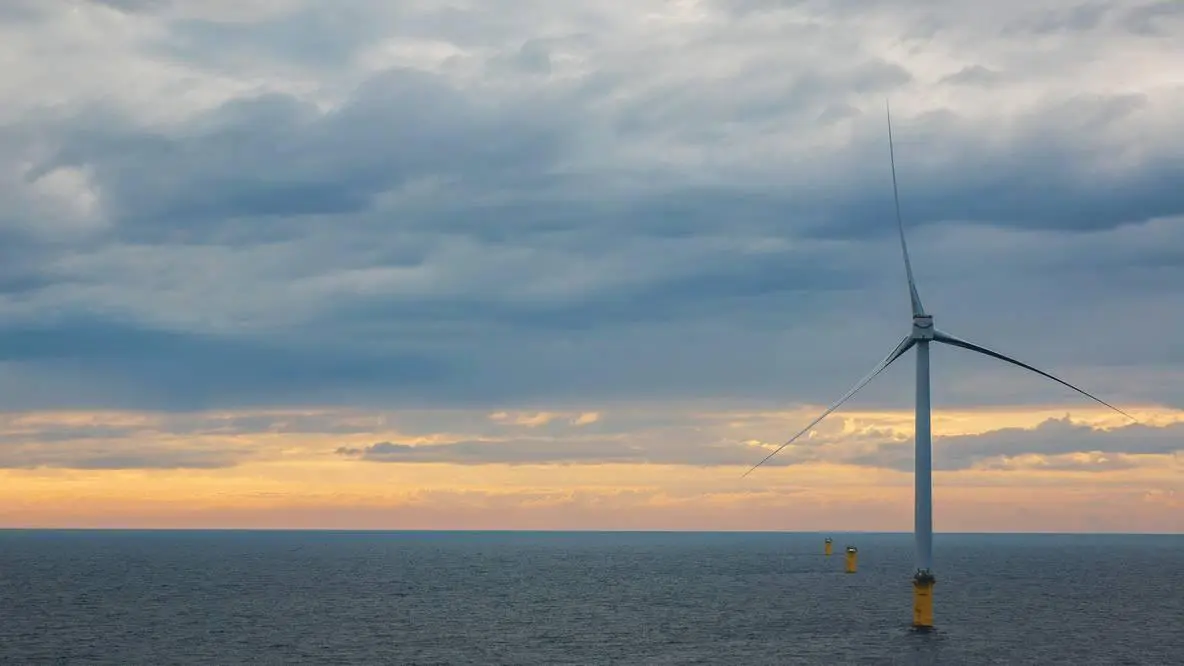


The 3.6-GW Dogger Bank Wind Farm is being constructed in United Kingdom waters 80 nautical miles (130 km) off the coast of Yorkshire and in the UK’s North Sea in three 1.2-GW phases known as Dogger Bank A, B, and C. The first turbine at Dogger Bank A has started turning and producing electricity. Power from the offshore wind farm is now being transmitted to the UK’s national grid via Dogger Bank’s high-voltage direct current (HVDC) transmission system, marking the first-time use of HVDC technology on a UK wind farm.
First power followed the installation of the first of General Electric (GE) Vernova’s Haliade-X 13-MW turbines, one of the largest and most powerful globally, at the Dogger Bank site. This is the first time GE Haliade-X units have been energized offshore anywhere in the world. Each rotation of the 351-ft.- (107-m-) long blades can produce enough energy to power an average British home for two days.
Equinor, as lead operator during the operational phase of the wind farm, will maintain and operate Dogger Bank over its expected 35-year lifetime. Operations and maintenance (O&M) will be carried out from the recently opened O&M base at the Port of Tyne. The base will host around 400 jobs, including staff from the Dogger Bank Wind Farm, Equinor, GE Vernova, and North Star.
Dogger Bank sits off the coast of Yorkshire and will occupy an area almost as large as Greater London and nearly twice the size of New York City. When fully complete, its 3.6-GW capacity will comprise 277 offshore turbines capable of producing enough energy to power the equivalent of 6 million British homes annually.
The first power milestone marks the first of what will eventually be 277,853-ft. (260-m) tall turbines providing power from the project. Each of these turbines will be progressively installed and commissioned between now and planned full commercial operation in 2026.
When complete, Dogger Bank will be the world’s largest offshore wind farm, more than two and a half times the size of the largest offshore wind farm currently in operation.
“Offshore wind is critical to generating renewable, efficient energy that can power British homes from British seas,” said UK Prime Minister Rishi Sunak. “It’s fantastic to see the world’s largest wind farm, Dogger Bank, generating power for the first time today from UK waters, which will not only bolster our energy security, but create jobs, lower electricity bills, and keep us on track for net zero.”
Dogger Bank is being developed and built by a joint venture comprising Equinor, SSE Renewables, and Vårgrønn (a joint venture of Eni Plenitude and HitecVision). SSE Renewables is lead operator for the development and construction phase while Equinor will be lead operator of the wind farm for its expected operational life. Vårgrønn brings specialist offshore wind expertise to the project.
“Set against the broader energy context, Dogger Bank, the world’s largest offshore wind farm demonstrates the best of what the offshore wind industry can offer, with innovative technologies, long-term jobs, and economic growth and security of electricity supply at a major scale,” said Anders Opedal, chief executive officer (CEO) of Equinor. “A renewable mega-project like Dogger Bank constitutes an industrial wind hub in the heart of the North Sea, playing a major role in the UK’s ambitions for offshore wind and supporting its net-zero ambitions.”


“There has been lots of talk about the need to build homegrown energy supplies, but we are taking action on a massive scale,” said Alistair Phillips-Davies, CEO of SSE. “Dogger Bank will provide a significant boost to UK energy security, affordability, and leadership in tackling climate change. This is exactly how we should be responding to the energy crisis. The innovations this pioneering project has developed will mean future developments can be built faster and more efficiently, accelerating the clean energy transition. Now, of course, the challenge is to accelerate the next wave of these projects and we look forward to working with governments to bring these forward as soon as possible.”
Equinor said that the Dogger Bank project has delivered several world-firsts in supply chain delivery that will significantly accelerate the speed at which future offshore projects can be developed. GE Vernova’s new 13-MW Haliade-X turbine technology was completed by technicians and engineers working off Jan De Nul Group’s newest jack-up installation vessel, Voltaire. With a lifting capacity of 3527 tons (3200 tonnes), the Voltaire is the largest offshore jack-up installation vessel of its kind in the world and the first ultra-low emissions ship of its kind.
Dogger Bank also marks the first use of HVDC transmission technology to connect a British wind farm to National Grid’s UK energy network. This includes the installation of the world’s first unmanned offshore HVDC substation platform at the site, as well as first use of Hitachi Energy’s HVDC Light transmission system which was executed in record time of 38 months with the highest safety and quality standards.
More than 2000 UK jobs have been created or supported in relation to the construction and operation activities of Dogger Bank. Many of these are based in the north of England, where the project’s supply chain is creating long-term opportunities for people just starting out in their careers, as well as more experienced workers transitioning from other industries to renewable energy.